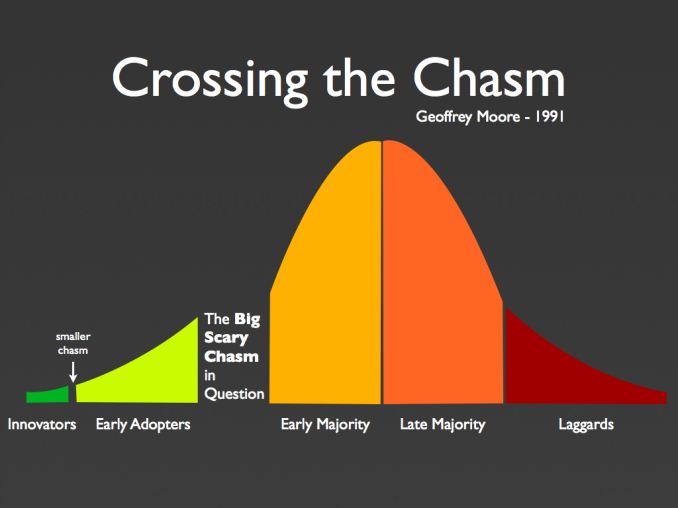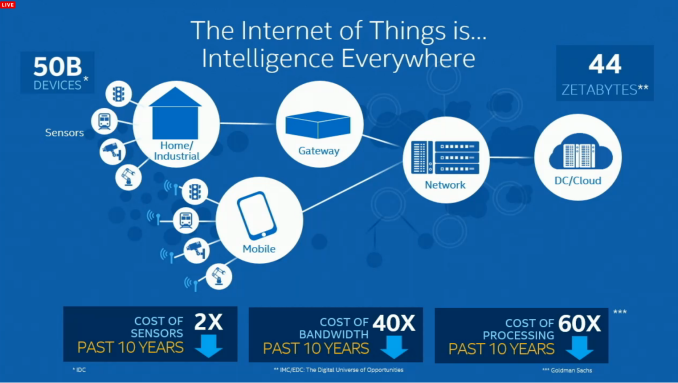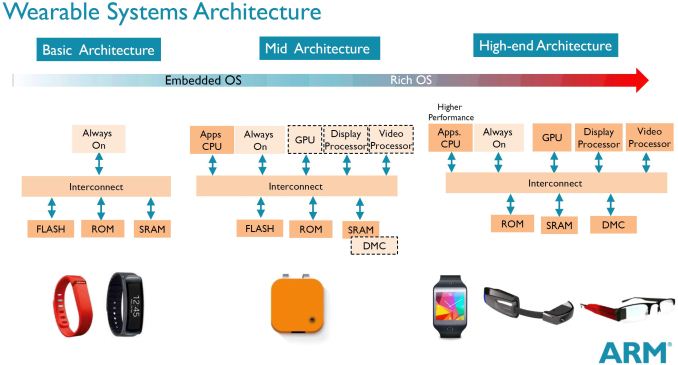Wearables: 2014 and Beyond
by Stephen Barrett on January 15, 2015 11:50 AM EST- Posted in
- Wearables
- Apple
- Microsoft
- pebble
- Android Wear
- Microsoft Band
- Fitbit

As the year 2014 has come to a close, now is a good time to inventory changes in the consumer electronics market and project those trends forward. One of the most obvious changes was that wearable technology has, by my observation, approached the brink of the adoption chasm into the early majority. In this article we will focus on the significant business and consumer factors of wearable technology, the notable introductions in 2014, as well as future AnandTech coverage.
If you are unfamiliar with ‘the chasm’, this is a reference to an acclaimed technology marketing book by Geoffrey A. Moore in 1991. As seen in the figure below, Geoffrey describes five stages of adoption.
The first, consumers described as innovators, are on the very bleeding edge. Innovators have a combination of unique interest in the subject area and abundant disposable income. There is a small chasm between this group and the next. This small chasm has killed many technologies and you could probably argue that 3D TVs died here. Next, early adopters are more like typical AnandTech readers. These consumers are technologically savvy and often the technology go-to person for groups of family and friends. Early adopters are likely to have made investments into products that their friends have yet to invest in themselves. My wife described me this way when I made the jump from iPhone to Windows Phone. It was an early product without majority adoption (and still is), but I wanted it anyway.
This brings us to The Big Scary Chasm in Question. How does a technology explode from a “hobby”, as famously Apple described its Apple TV, to a staple like the iPhone? In the information age of today, crossing this chasm is primarily a focus of marketing. Sure, you need good product, but without effective marketing there is little chance of wide adoption. There are plenty examples of products that have been favorably reviewed by AnandTech and others but didn't see widespread adoption. Often, it's a case of competing against the marketing budget of a much larger company, but that's a topic for another day. In short, going from a cult hit to a market leader is difficult; hence, the Chasm.
Taking this back to wearables, 2014 saw the most marketing of wearables yet, and for good reason. The traditionally explosive smartphone and tablet markets are slowing down. Analysts at CCS Insight projected a fall of smartphone sales' yearly growth from 40% in 2013 to 25% in 2014 and 15% in 2015. Analysts at Gartner project a fall of tablet sales' yearly growth from 55% in 2013 to 11% in 2014. IDC projects 2014 tablet growth even worse at 7%. At the same time, wearable revenue is projected to dramatically grow. ABI Research projects wearable technology at a compound annual growth rate (CAGR) of 56.1% over the next five years. Finally, Price Waterhouse Coopers’ interview samples show that 76% of consumers do not need a new wearable device to replace functionality of an existing device.
The top consumer eco system players – Apple, Microsoft, Google, and Google’s partners – are growth companies. Continually increasing revenue is a corporate foundation. Without revenue growth, careers stagnate as no promotions or raises are possible. Go long enough without growth and your top talent can leave for a company with growth opportunity. In Samsung’s recent 3rd Quarter financial results, their revenue fell 20% year over year and Samsung primarily attributed this to smartphone struggles.
With all this data combined, it is a no-brainer for these consumer companies to shift resources to wearables. Therefore, all have made significant wearable announcements. Google’s partners and Microsoft have launched devices while Apple is alone in the laggard position of having nothing on the market (with Apple Watch coming this year).
Wearables: What Are They?
At their core, wearables are of course technological devices that you wear. In some sense, your smartphone is actually a wearable. Even though a smartphone usually does not directly contact your body, it is a wearable just as much as a smart purse or backpack is a wearable. However, as smartphones are already a category of their own, they are traditionally excluded even though the core technology is vastly similar. That core technology consists of sensors, wireless, storage and computing. Intel’s recent IoT (Internet of Things) platform launch contained a slide detailing the cost reduction of some of these components, which is an enabling factor of wearable growth.
Where wearables differ from smartphones is their function. By breaking from the traditional smartphone form factor a wearable can provide different benefits. These benefits can be broken down into different categories that closely mirror the contents of the device as different sensors, processors, wireless, and storage enable different use cases.
On the left side of the above diagram from ARM are devices that contain wireless connectivity, sensors, a low power microcontroller such as Coretex-M, small amounts of memory and storage; run an embedded OS; and potentially have an optional display. The vast majority of these devices today are for fitness and health, however some provide smart watch functionality as well. On the middle and right side of the diagram are devices that integrate higher end processing and storage such as full-blown application processors (think Cortex-A series) and DDR memory. These allow running richer, non-embedded operating systems (such as Android) and higher-end features at the cost of power consumption.













79 Comments
View All Comments
loki1725 - Monday, January 19, 2015 - link
I'm one of the people that has yet to see a need for the wearable, but my wife uses her Fitbit a LOT, and it's changed some aspects of her daily routine.For the fitness side of things, one of the aspects of devices I would like to see reviewed is accuracy. I have two data points (not enough for a full conclusion, but definately enough for an opinion) on fitness trackers accuracy and I would like to see that expanded.
When you review things with pedometers, compare their recorded steps to actual steps. I tried to use an app on my smart phone, and it recorded 15 steps when I shook the phone a few times, and 8 steps while I took my dogs on a 2 mile walk. We've also put my wife’s FitBit on our dogs collar while playing fetch. That earned her 800 extra steps for the day in about 10 minutes.
The other options like calories burned and active minutes tracked seem very suspect to me on many devices. The amount of assumptions you have to make to get from something like hear rate to calories is pretty large, and I doubt this is very accurate.
kashyapvijay - Wednesday, January 21, 2015 - link
$125 Citizen Eco drive (no battery; runs forever) watch is much better value compared to $300 wearable, which only coverts my pocket watch (phone watch function) into a wrist watch. Wearable has to lot more (blood pressure measurement, blood glucose measurement, medicine injection, etc.) before it can justify claim on wrist, a very scarce real estate.GuardianAngel470 - Wednesday, January 21, 2015 - link
For those wondering whether anyone even wears watches anymore, I'm 6' 3" and virtually no chair I regularly come across is designed for my height or greater. Digging my phone out of a pocket that is at a < 90 degree angle to my torso is not even remotely convenient enough for me to forgo a watch, especially as phones grow in size.And for me, the question is really why would I bother getting used to that? Less than a second to check the time, date, and day on my wrist or 5, 10, even 30 seconds for a big phone in a sturdy case stuck obstinately in my pocket; the choice is a flat out no-brainer.
My watch is, for all my purposes, completely waterproof, won't blind me at night, is completely invisible in terms of comfort, is more durable than a Nokia 3310, and needs a new battery every year and a half. Not a single smart watch, cell phone, or otherwise offers all of those features, especially not for under $60.
So yeah, I still wear a watch. When a smart watch manages to be waterproof down to 100M, low brightness, incredibly comfortable, nigh indestructible, and doesn't need to be charged for a year, then we'll talk.
eldakka - Thursday, January 22, 2015 - link
What I don't want in a smartwatch:1 microphone
2 camera
3 speaker
With the ability to surreptiously turn on these functions that various criminal and governmental (same thing these days really) organisations have my sony smartwatch that doesnt havr any of these features is perfect.
When I have an important/confidential meeting (e.g. doctor, financial consultant, business meeting, stripper ahem) I can leave the phone on but outside the room, within bluetooth range, and hold my conversation without any privacy implications while also still being able to receive important notifications (incoming calls, sms).
I dont need to be able to make/receive calls on the watch itself, thats what the phone is for.
halcyon - Thursday, January 22, 2015 - link
It will be all about sensors, software ecosystem, looks and price.Samsung doesn't get it.
microsoft half gets it.
Apple gets it, but of course, is a closed ecosystem (it's a mere 16% of the mobile market, regardless of what people in the USA think). Also, Apple skips on the sensors.
Intel's owned Basis has the sensors, but it looks like cr*p and support is....well... it's not buried on the Intel graveyeard to languish like all their other purchases.
Fitbit is a passing phenomenon, somebody will pick them up for dollars or they will just wither away in the next 3 years.
Then there are the specialists.... Polar.... Suunto.... Garmin and others.
They could theoretically do something wild: great looks, cross-platform (good support!), plenty of sensors, great for sportspeople... But they are too un-innovative, too slow and have too meager resources.
In the end, Apple will rule their own segment. Some people will mistakenly think it's the whole universe.
Samsung will spam with a huge portfolio and some of them will float - eventually.
LG doesn't get it.
THen there's the Swiss entry. It will happen this year or the next year from the Swatch group. They have too much to lose.
They know fashion like no other. They know how to brand. They have good distribution. Mass production. Software and really understanding smart wearables is not their thing.
The market is just barely starting to be carved out -- it can't even be divided yet.
But it looks like almost all of the offerings are "meh" at best.
In five years, let's take another look :-)
Will Robinson - Friday, January 23, 2015 - link
Nice article but did the author really just use "inventory" as a verb in the first sentence?wtf?
yhselp - Friday, January 23, 2015 - link
Consult a dictionary. It can be used as a verb, and not just in American English. In this case, it's been used as "to summarize".g00ey - Saturday, January 24, 2015 - link
Pain in the ass? The headphones are supposed to be worn in the ears, not up the hiney :)cyberssd - Friday, January 30, 2015 - link
Screen size & aspect ratio are most important to me. Small square screens just don't cut it. Manufacturers need to think ultrawide 21:9.